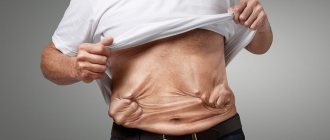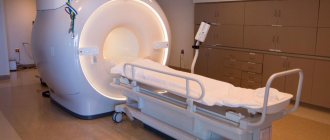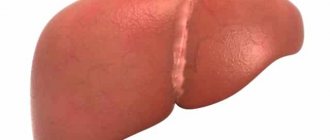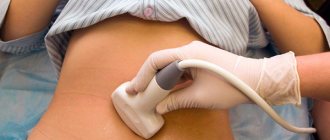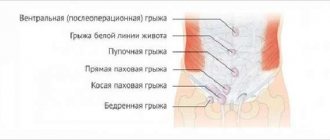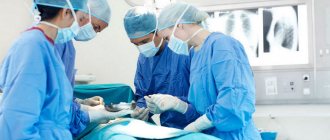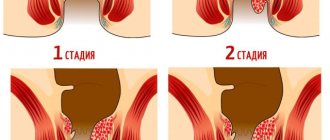The mechanism of formation in men
Types and locations of external abdominal hernias
Most often, symptoms of abdominal hernia are found in men, in approximately 90% of all patients. This is due to the anatomical features of the male body and increased physical activity, including sports.
The most common type of hernia is inguinal, localized in the lower abdomen. It is detected when the organs are displaced into the inguinal canal, which occupies a narrow area between the abdominal muscles. In women, on the contrary, the most common type is abdominal or umbilical.
The main criterion for classifying neoplasms is the method of appearance of the formation:
- Congenital. They are formed during intrauterine development and are often associated with genetic abnormalities. Often the formation of the pouch occurs against the background of insufficient development of the abdominal muscles and associated organs. Often, premature babies have organs that are not sufficiently overgrown with muscle tissue.
- Purchased. Appear when there is excessive pressure on the abdominal organs. The condition can be provoked by heavy lifting and constant constipation. In men, signs of a hernia in the abdominal cavity are often detected against the background of obesity or rapid weight loss, since the stretched muscles do not have time to return to normal.
Predisposition to pathology can vary greatly among people, but it is often associated with a hereditary factor.
Causes of pathology
One of the main reasons for the appearance of acquired pathologies is the incompetence of the abdominal wall, resulting from the specifics of its structure. There are particularly delicate places in the abdominal muscles where the likelihood of disease formation is always high. Cases where the integrity of the muscles is disrupted due to abdominal operations or injuries belong to the same category. At the same time, pathology can develop completely imperceptibly for the patient, even without noticeable efforts or loads.
There are also other factors that cause incompetence of the walls of the groin area and the appearance of protrusions in these places.
This includes:
- genetic predisposition,
- age-related tissue transformations
- extreme weight loss due to prolonged fasting or illness (lack of protein in the diet always leads to weakening of muscle tissue),
- stretching of the muscle wall due to pregnancy, obesity, ascites, etc.
Factors that lead to an increase in intra-abdominal pressure, such as:
Types of hernias in men
Modern medicine does not separate inguinal and femoral sac-like formations from those that are formed exclusively in the abdomen, according to the method of formation and severity of development. The main types of abdominal hernias in men are closely related to the groin area.
Inguinal hernia

Inguinal hernia
They occur most often, in approximately 95% of cases among all formations of this nature. They can be congenital, when complete fusion of the vaginal process of the peritoneum does not occur, or acquired. The latter are most often found in adults and are divided into several types:
- Oblique. They pass through the groin and are more often found in middle-aged men.
- Direct. They pass through the internal fossa next to the scrotum in the area of the inguinal ligament. They often occur in old age and are bilateral in nature.
- Sliding. One of the walls of the formation is connected to the cecum or bladder. Symptoms from the urinary system and pain are often observed.
Signs of groin pain appear after physical activity. During diagnosis, they are clearly visible, especially in a vertical position.
Femoral hernia
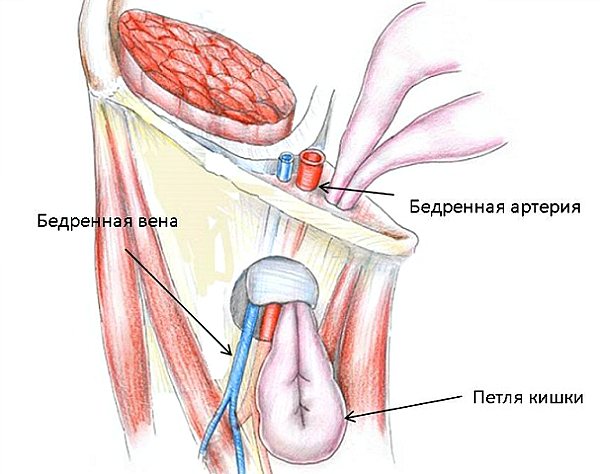
Femoral hernia
The hernia is located in the lower abdomen in men whose femoral ligaments are very weak. Occurs in less than 5% of cases. The formation can be felt on the inner surface of the thigh under the inguinal ligament.
Umbilical formation
It is found mainly in children in the first 6 months of life and is associated with abnormal development of the abdominal wall. In adults, it occurs in the form of a small protrusion in the navel area. More often accompanies re-pregnancy in the absence of exercise. When a lump appears in a man, it is important to conduct a differential diagnosis and eliminate suspicion of gastric cancer metastases.
Hernia of the white line of the abdomen
It occurs in men in cases where the aponeurosis is weakened - there are gaps with adipose tissue through which organs emerge. They can be located above or below the umbilical region. Sometimes a bulge is observed directly in the navel, causing symptoms to be confused with a mass in this area.
Classification by appearance factor

Also, hernias in men can be traumatic and postoperative, forming in the scar area:
- due to divergence of the stitched aponeurosis or a defect in it;
- with improper care and wound suppuration;
- with excessive physical exertion after surgery.
If an injury occurs, the risk of a hernia increases when the ligaments rupture.
Sometimes rare types occur - neoplasms of the xiphoid process due to a defect in the lower part of the sternum and hernia of the semilunar lateral line. The latter occurs when there is a defect in muscle tissue.
Internal hernias
They are diagnosed when the abdominal organs move into separate crevices, pockets of the parietal peritoneum. Sometimes the organs move into the chest cavity, then a diaphragmatic hernia is formed. Sometimes the place where the sac emerges is the unsutured slits of the abdominal cavity. The symptoms of such a hernia are often similar to intestinal obstruction, accompanied by vomiting, acute cramping pain and severe bloating with stool retention.
Intestinal hernia. Vector and Photo (Free Trial)
Loans are valid for up to one year
Download
| PV | in | cm | Loans | |
| Small | 900 x 900 12.5 x 12.5 inches (72 dpi) 31.8 x 31.8 (72 dpi) | 1 |
| average | 1600 x 1600 5.3 x 5.3 inches (300 dpi) 13.5 x 13.5 (300 dpi) | 2 |
| big | 3000 x 3000 10" x 10" (300 dpi) 25.4 x 25.4 (300 dpi) | 4 |
| Vector | Scalable .eps file | 6 |
| Extended License | Scalability.eps file | 50 |
Sizes are for subscriptions and credits
,
Signs of hernia development in men

One of the signs of a hernia is a bursting sensation
An external abdominal hernia in men can be recognized by its obvious symptoms:
- pain and bursting sensations;
- movable protrusion, which, in the absence of infringement, is easily reduced;
- with the development of pathology, the hernial sac enlarges;
- fever and acute pain appear when the contents of the hernia are strangulated.
The pain often appears only after physical activity, and disappears completely at rest. A hernia may also be accompanied by constipation, vomiting and nausea. When a person takes a lying position, the hernial protrusion disappears.
In the early stages, an abdominal hernia in men may not manifest itself in any way, disturbing the patient only when coughing or straining. When the gate expands, the tumor rapidly increases, which leads to certain dangers and complications.
Features of symptoms depending on the location of the hernia
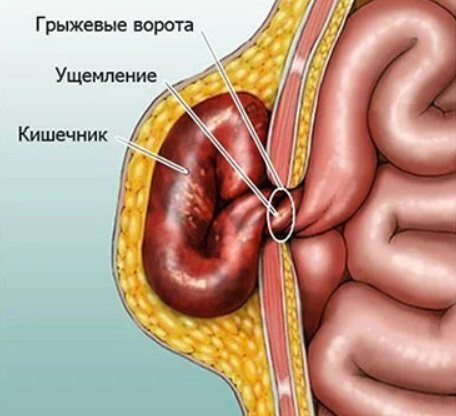
Intestinal loop formation
Each hernial formation has unique symptoms if one or another organ gets into the sac:
- Intestinal loops. Symptoms of acute intestinal obstruction develop and the temperature rises.
- Bladder. There are problems associated with urination.
- Hernia of the white line. The protrusion occurs in the area of the anterior wall, pain appears in the epigastrium.
- Groin. Symptoms are localized in the lower abdomen, in the groin.
- Navel. Attacks of nausea often occur, and pain is noticeable on palpation.
- Femoral hernia. The pain radiates down the abdomen when the patient tries to fully straighten up. Some men have difficulty urinating.
When the hernial sac is strangulated, the symptoms become acute, and the type of pathology can only be determined by external examination of the protrusion and instrumental examination.
How to treat?
Treatment generally involves surgery and repair of the hernia.
Surgery may also be delayed due to being too young or too old.
Operation
Laparotomy is used as the main and recommended method of treatment. With this surgical operation, access to the formation is gained through an incision in the body in the abdominal area.
To eliminate the protrusion, a special patch made of mesh fabric is used, which is inserted into the required place and holds the hernia. The frequency of hernia recurrence with this treatment does not exceed 1-2%.
Folk remedies
There are many examples on the Internet of treating abdominal hernia using traditional methods. However, you should never trust them. None of the methods can give results.
Only surgery can help. None of the hernias can disappear on their own. The only exceptions are umbilical hernias in children, which in some cases go away on their own before the age of 5.
Massage is used if children have an umbilical hernia. This allows you to strengthen the umbilical ring, which should restrain the prolapse of organs into the hernial sac.
Gymnastics prescribed by a doctor, with constant use, can give a decent result and the child’s hernia will go away over time. This way you can protect your baby from future surgery.
Complications of abdominal hernia in men
Strangulation of the sac can be both a stage of development of a hernia and a complication. When this happens, the tissues of the pinched organs stop receiving blood and oxygen. This causes them to die, which leads to organ dysfunction. In some cases, perforation of intestinal loops is possible. When perforated tissue is perforated, peritonitis or acute internal bleeding develops.
Abdominal hernias occur 50 times more often in men than in women. This is due to the peculiarities of the lifestyle of the stronger sex. Ignoring the symptoms can lead to the growth of the hernial sac and complications that are dangerous to health.
inguinal hernia images, stock photos and vectors
You are currently using an older version of the browser and your experience may not be optimal. Please consider upgrading. Learn more. ImagesImages homeCurated collectionsPhotosVectorsOffset ImagesCategoriesAbstractAnimals / WildlifeThe ArtsBackgrounds / TexturesBeauty / FashionBuildings / LandmarksBusiness / FinanceCelebritiesEditorialEducationFood and DrinkHealthcare / MedicalHolidaysIllustrations / Clip-ArtIndustrialInteriorsMiscellaneousNatureObjectsParks / OutdoorPeopleReligionScienceSigns / SymbolsSports / RecreationTechnologyTransportationVectorsVintageAll categoriesFootageFootage homeCurated collectionsShutterstock SelectShutterstock ElementsCategoriesAnimals / WildlifeBuildings / LandmarksBackgrounds / TexturesBusiness / FinanceEducationFood and DrinkHealth CareHolidaysObjectsIndustrialArtNaturePeopleReligionScienceTechnologySigns / SymbolsSports / Recrea tionTransportationEditorialAll categoriesEditorialEditorial HomeEntertainmentNewsRoyaltiesSportsMusicMusic HomePremiumBeatToolsShutterstock EditorMobile AppsPluginsImage ResizerFile ConverterCollage MakerColor SchemesBlog HomeDesign
